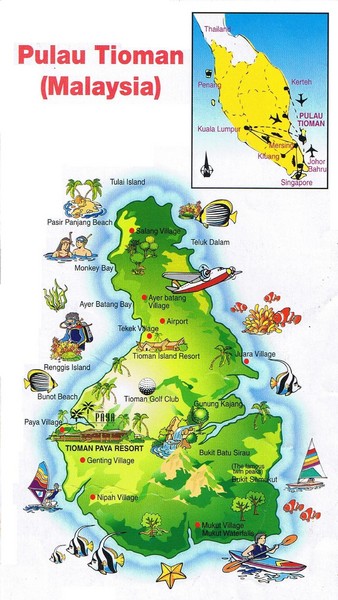On my second day on Tioman Island I didn’t do very much. Just relaxing at the beach, a little swimming and walking around taking some pictures. While laying on the beach I met Lim, a great guy from Germany who’s also living in my “resort”. We talked a little and then went back to our huts.. We had a great tie with good and cheap food Lim and I found out, that we all wanted to do the jungle Trek from our beach to the other side of the island to a place called Juara. It’s like 7,2km one way and is supposed to be like a good 2h walk. We decided to meet the next day at 10 am and do it together.
We walked into the jungle, the scenery was really amazing: everything so green and sounds you couldn’t imagine:

But after a few minutes walking up (a mix of natural “stairs” and concrete stairs), as the trek was going over the “small” hill in the middle of the island, I was sweating like HELL. And as I didn’t had any breakfast that morning, I was running out of energy a few minutes later and climbing up the jungle got really, really exhausting for me. But on the other hand, the nature surrounding us was well worth the effort.

After an exhausting 90 minutes we arrived and the top of the hill and the trek got flat and soon started to go downhill, which felt a bit like heaven…but as this was a concrete road now, it was still very tiring for the feed, as you always had to break, if you didn’t want to get to fast. But through the jungle you could already get a glimpse at the ocean and now we really wanted to get to the beach, which was supposed to be even more beautiful than the one at our side of the island, as others told us.

Minutes later we arrived at this amazing beach, which looked just like a picture on one of those tropical postcards. I was pretty much stoked! And as this place was still pretty much closed (only like 2 or 3 open restaurants and no open bungalows), we were the only ones around. There weren’t even any local people around.
We put down our things and went straight into the water. This beach had some pretty cool waves, as this side of the island was facing the open ocean. When we went back out of the water, we discovered, that the beach was full of sand flies. These very little creatures, about the size of a food fly, were biting us everywhere and it got very annoying to keep them away. But besides them, this beach was just like paradise. Again. ![]() We stayed there for about 4h and just enjoyed this wonderful place.
We stayed there for about 4h and just enjoyed this wonderful place.

We then had to leave in the early evening, because we wanted to get home in daylight. As none of us liked the idea of walking up the hill again, we asked around if we could find someone that could take us with him in his car. But it was very expensive, so we decided to go by foot. We stocked up with fresh water and starting walking again. As before, getting up the hill was very exhausting but when we finally arrived back at the top, going down was now just a walk in the park, and now we could really enjoy the jungle around us!When we finally arrived at our side of the island it just started to get dark.Afterwards we walked back and fell happily in our beds.







